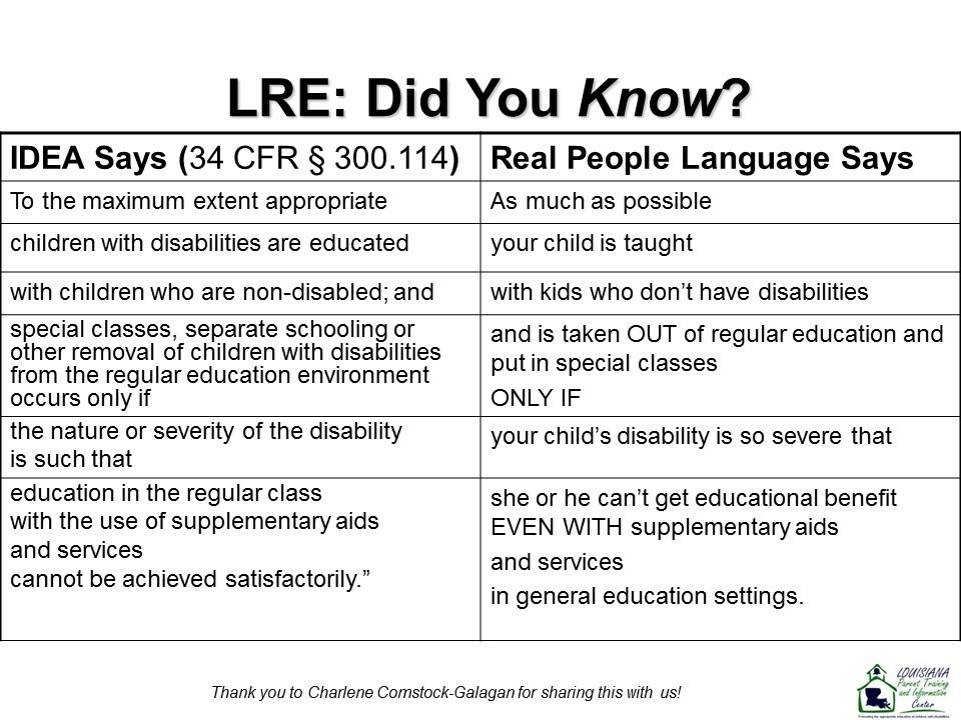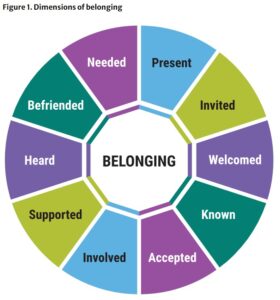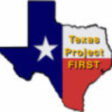Least Restrictive Environment, or LRE, means that as much as possible, your child is taught with children without disabilities. Your child is only taken OUT of the general education classroom and put in “special” classes ONLY if your child’s disability is so severe that he or she cannot get an educational benefit, EVEN WITH supplementary aids & services in the general education setting.

Texas Project FIRST (Region 9 ESC) resources:

- Placement Decisions / Colocación
- Planning Matrix / Matriz de Planeación del IEP
- Instructional Arrangements / Situaciones (o Arreglos) de Instrucción
- Why Inclusion Begins in Kindergarten (pdf) / Por qué la Inclusión comienza en Kindergarten (pdf)
Texas Education Agency resources related to Least Restrictive Environment and Access to the General Curriculum:
- Inclusion in Texas – Statewide leadership for inclusive practices in Reading/Math, Early Childhood Special Education, Assistive Technology and additional resources. Resources include many updated versions of items contained on the previous Progress in General Curriculum site (Specially Designed Instruction, UDL Implementation, Co-Teaching Guidelines, Working with Paraprofessionals, etc.)
- IEP Development July-2020 (pdf)
- Question & Answer IEP Measurable Annual Goals(pdf)
- LRE Question & Answer Document 2017 – ESC20 Progress in General Curriculum
- Preschool LRE Question & Answer Document 2017 – ESC20 Progress in General Curriculum
- The Legal Framework for the Child Centered Special Education Process (Region 18 ESC) – Least Restrictive Environment
- Assumptions that Hinder Inclusion of Students with Complex Needs (video)
**************************************
Center for Inclusive Child Care – This website is a centralized, comprehensive resource network supporting inclusive care for children in community settings. They have a variety on online training modules and tool kits.
Center for Parent Information and Resources – This link takes you to CPIR’s section on “Placement Issues.” Also available in Spanish.
Center on Human Policy – Resource page of the Center on Human Policy, a Syracuse University based organization that studies and promotes inclusion for people with disabilities. Information about the organization and its publications are provided as well as an extensive list of web links to other disability resources.
Disability is Natural – Various articles on new ways of thinking around education, inclusion and therapy.
Early Childhood Technical Assistance Center – Tools for Understanding LRE and Research & Studies on Inclusion
Center on Disability and Inclusion – The Inclusion Institutes are a consortium of research and service projects related to inclusive education affiliated with the School of Education of Syracuse University. These projects include the Institute on Communication and Inclusion, and Taishoff Center for Inclusive Higher Education.
Inclusion Press – The home page of “Inclusion Press”, self-described as “a small independent press striving to produce readable, accessible, user-friendly books and resources about full inclusion in school, work and community.” The site includes books, videos, web links, newsletter highlights, and workshops.
Inclusive Schools Network – This website offers a forum for educators, students, family, and community members to share experiences and ideas with each other. Included is a self-assessment tool for schools to guide a review of current practices regarding inclusive education, additional resources and success stories.
IRIS Center – Inclusion Of Students with Significant Cognitive Disabilities: Supports in the General Education Classroom
Accediendo al currículo de educación general:Consideraciones para la inclusión de estudiantes con discapacidad
Kids Together, Inc. – The web site of Kids Together, Inc. whose mission is to “promote inclusive communities where all people belong”. It includes information and web links on inclusive education, supported employment, obtaining assistive technology, legislation, people first language, and more. It also contains some light-hearted cartoons and “top ten lists” that many parents can relate to.
National Association for the Education of Young Children (NAEYC) and Division of Early Childhood (DEC) – Joint Position Statement on Early Childhood Inclusion
National Arts and Disability Center – A project of the University of California Los Angeles, the NADC promotes the full inclusion of audiences and artists with disabilities into all facets of the arts community.
CAST (formerly National Center for Universal Design) – Universal Design for Learning is a set of principles for curriculum development that give all individuals equal opportunities to learn. UDL provides a blueprint for creating instructional goals, methods, materials, assessment that work for everyone – not a single, one size fits all solution, but rather flexible approaches that can be customized and adjusted for individual needs. This web site Defines UDL and its Three Principles, offers guidelines, explains the components of UDL curricula, research, as well as an extensive resource library in a variety of media.
National Inclusion Project – Through innovative programs and strategic partnerships, NIP are leading the way for inclusive communities nationwide. \”Let’s ALL Play\” provides a program model for recreational programs seeking to improve the way they implement inclusion. \”Together We Make a Difference\” is an effective service learning curriculum tool that teachers and program providers can use to help all children make an impact. They also offer other grants for those seeking to make a difference in their communities with inclusive programs and families seeking to benefit from inclusive programs.
Pacer Center Resources – Appropriate accommodations so my child can participate in the general education classroom
Paula Kluth’s Inclusion Rules – This website is dedicated to promoting inclusive schooling and exploring positive ways of supporting students with autism and other disabilities. There are a number of articles on inclusive schooling and differentiating instruction.
Project Participate – This is the website of Project Participate providing “practical solutions to enhance learning, teaching, and the full inclusion of students with disabilities in the classroom. Project Participate facilitates team collaboration and the appropriate use of technology in the classroom.”
TASH – The website of TASH, an international non-profit organization working for “equity, diversity, social justice and inclusion” for people with disabilities. The site provides information on TASH including their mission statement, resolutions, and policy statements; conference information; publications; web links and more.
Texas Center for Disability Study – The Texas Center for Disability Study is one of 66 University Centers on Excellence in Developmental Disabilities Research, Education and Services (UCEDD). Their mission is “to serve as a catalyst so that people with disabilities are living the lives they choose in supportive communities.” Their Inclusion – why do it? video provides a short summary of the benefits of Inclusion.
Texas A&M Center on Disability and Development – The TAMU Center on Disability & Development is one of 66 University Centers on Excellence in Developmental Disabilities Research, Education, and Services (UCEDD). They support self-determination, community integration, and quality of life of people with disabilities and their families.
Texas Council for Developmental Disabilities – TCDD works to create change so that all people with disabilities are fully included in their communities and exercise control over their own lives. This site includes information on grants, their FYI newsletters, links to resources, and more.
The Inclusive Class – Strategies and solutions for teaching students of all abilities.
United Cerebral Palsy – This link takes you to UCP’s “Case for Inclusion” report, which ranks all 50 states and the District of Columbia (DC) on outcomes for Americans with intellectual and developmental disabilities (ID/DD).
U.S. Dept. of Education — Q&A on IEP FAPE Requirement & Implementation Considerations (pdf)
Whole Schooling Consortium – This is the home page of the Whole Schooling Consortium. “In Whole Schools, children with substantial differences learn well together – students with mild to severe disabilities, gifted, from many cultures and ethnic groups.”




